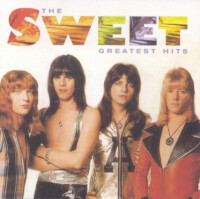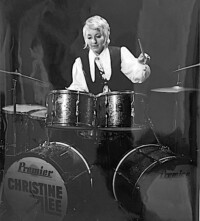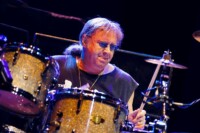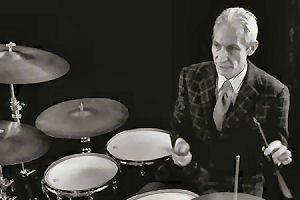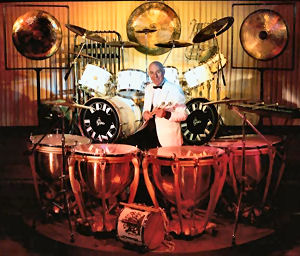 The first time I heard the hambone rhythm (also known by its African name of Juma and 3/2 clave) was on a record called ‘Willie And The Hand Jive’ by the ’Johnny Otis Show’ . This band was somewhat unusual for the time being led by a drummer. This would have been in 1958 and a year or so later, Bo Diddley came up with a one chord song using the same evocative rhythm and bestowed his own name on it forever. It’s an infectious maraca led, tom tom- based rhythm which is very danceable and great fun to play. But there was a great deal more to Johnny Otis than that rhythm and his hand jive song’s allegedly dubious lyrics.
The first time I heard the hambone rhythm (also known by its African name of Juma and 3/2 clave) was on a record called ‘Willie And The Hand Jive’ by the ’Johnny Otis Show’ . This band was somewhat unusual for the time being led by a drummer. This would have been in 1958 and a year or so later, Bo Diddley came up with a one chord song using the same evocative rhythm and bestowed his own name on it forever. It’s an infectious maraca led, tom tom- based rhythm which is very danceable and great fun to play. But there was a great deal more to Johnny Otis than that rhythm and his hand jive song’s allegedly dubious lyrics.
Johnny Otis was born Ioannis Veliotes on December 28th, 1921 in Vallejo, California. He moved north to Berkley where his father, having originally been a longshoreman, became a grocer. The area he lived in was a predominantly black one and even though he was of Greek extraction, it was here that he decided he was ‘black by persuasion’. Eighteen years later (1939) having seen Count Basie’s band at the World’s Fair in San Francisco, Jo Jones became his hero and would influence him for the rest of his life (he actually substituted for him with Basie). He was so keen about being a drummer that he forged his dad’s signature on the necessary forms to purchase a drum kit by instalments.
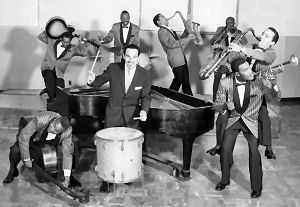 By now he had become the drummer with a blues band – ‘Count Otis Mathew’s West-Oakland House Rockers’ – and this is where he learned his craft. In 1943 he was playing a residency with the ‘Otis Love Band’ at a club in Nebraska when Jimmy Witherspoon and Nat King Cole recommended he move to Los Angeles. He took their advice and joined Harlan Leonard’s Rockets at the Club Alabam on Central Avenue (which was owned, incidentally, by another drummer called Curtis Mosby whose house band played with the likes of Duke Ellington). Within a couple of years Johnny Otis led his own 16 piece band there and both Charlie Parker and Miles Davis sat in with them. This would be around 1946 when he had his first hit with ‘Harlem Nocturne’ and toured the US with ‘The Inkspots’. By this time Johnny was an accomplished big-band drummer having played with many of the greats including Count Basie, Charlie Parker, Lester Young, Illinois Jacquet and Lionel Hampton.
By now he had become the drummer with a blues band – ‘Count Otis Mathew’s West-Oakland House Rockers’ – and this is where he learned his craft. In 1943 he was playing a residency with the ‘Otis Love Band’ at a club in Nebraska when Jimmy Witherspoon and Nat King Cole recommended he move to Los Angeles. He took their advice and joined Harlan Leonard’s Rockets at the Club Alabam on Central Avenue (which was owned, incidentally, by another drummer called Curtis Mosby whose house band played with the likes of Duke Ellington). Within a couple of years Johnny Otis led his own 16 piece band there and both Charlie Parker and Miles Davis sat in with them. This would be around 1946 when he had his first hit with ‘Harlem Nocturne’ and toured the US with ‘The Inkspots’. By this time Johnny was an accomplished big-band drummer having played with many of the greats including Count Basie, Charlie Parker, Lester Young, Illinois Jacquet and Lionel Hampton.
Club Alabam was the place to go to in LA and anyone who was anybody visited it to relax, watch the floor-show and listen to the music. Joe Louis probably didn’t do too much relaxing there because he trained at the club when he was in LA.
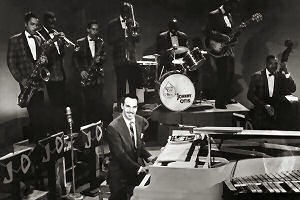 By 1947, the heyday of the big bands had passed and it was then that Johnny downsized his band to two saxes, trumpet, trombone and rhythm section. What he called “a small big band playing blues and that became Rhythm & Blues”. This band contained Bill Doggett, Jimmy Rushing and Johnny ‘Guitar’ Watson. The group he ended up with became the blueprint for the ‘Rhythm & Blues’ band as we now know it.
By 1947, the heyday of the big bands had passed and it was then that Johnny downsized his band to two saxes, trumpet, trombone and rhythm section. What he called “a small big band playing blues and that became Rhythm & Blues”. This band contained Bill Doggett, Jimmy Rushing and Johnny ‘Guitar’ Watson. The group he ended up with became the blueprint for the ‘Rhythm & Blues’ band as we now know it.
Just a year later Johnny Otis was ready to run his own club and opened ‘The Barrelhouse’ in Watts. This was the first nightclub to exclusively feature Rhythm & Blues. He had expanded his business activities even further by then and had moonlighted as chicken farmer. This was when disaster struck and he severed two of his fingers with a power saw while building a coop and this meant his drumming technique was affected although it didn’t interfere with his vibes playing.
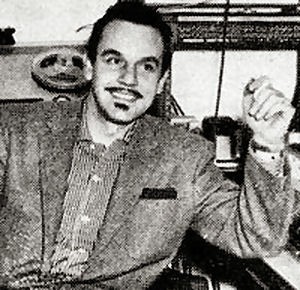 Johnny Otis wasn’t just a great drummer; he played piano, vibes, guitar, wrote songs, and in the fullness of time became a popular West Coast DJ on KFOX. His radio programme lasted for many, many years and eventually he graduated to his own TV Variety show on KTTV which ran for 8 years. He gave up touring in 1955.
Johnny Otis wasn’t just a great drummer; he played piano, vibes, guitar, wrote songs, and in the fullness of time became a popular West Coast DJ on KFOX. His radio programme lasted for many, many years and eventually he graduated to his own TV Variety show on KTTV which ran for 8 years. He gave up touring in 1955.
He was also something of a Svengali discovering and nurturing among many others: Esther Phillips, Big Mama Thornton, Etta James, Sugar Pie Desanto, Hank Ballard, Jackie Wilson and Little Willie John and the Robins (who became the Coasters). All of these artists went on to be featured vocalists in his band.
Johnny Otis not only discovered Big Mama Thornton, but he had a hand in writing ’Hound Dog’ for her (although due to a ‘technicality’ he never received any writing royalties). But he produced the record and played the drums when the guy booked for the session wasn’t getting it right – check her version out and see how timeless it is and how the feel still sounds funkily up-to-date. He also played on Johnny Ace’s ‘Pledging My Love’, wrote ‘Roll With Me Henry’ for Etta James, and he and his band backed Little Richard on several early records. In between 1950 and 1952 The Johnny Otis Show had no less than fifteen Top 40 hits!
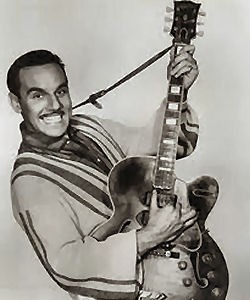 He wrote one of my very favourite songs for Jackie Wilson ‘In Every Beat Of My Heart’ which was actually recorded by ‘Gladys Knight and the Pips’ and became one of the 10 top ten hits he had in Billboard in 1950. He decided to get out on the road again with ‘The California Rhythm & Blues Caravan’ which became black America’s hottest musical attraction. He kept this band going until the seventies whereupon he became pastor of his own non-denominational church which was based in his house. This wasn’t his only stab at respectability though because he also ran (albeit unsuccessfully) for a seat on the California State Assembly. After that setback he became Chief of Staff for a Democrat Congressman.
He wrote one of my very favourite songs for Jackie Wilson ‘In Every Beat Of My Heart’ which was actually recorded by ‘Gladys Knight and the Pips’ and became one of the 10 top ten hits he had in Billboard in 1950. He decided to get out on the road again with ‘The California Rhythm & Blues Caravan’ which became black America’s hottest musical attraction. He kept this band going until the seventies whereupon he became pastor of his own non-denominational church which was based in his house. This wasn’t his only stab at respectability though because he also ran (albeit unsuccessfully) for a seat on the California State Assembly. After that setback he became Chief of Staff for a Democrat Congressman.
As I said, aside from all of this he somehow found time to become a very popular disc jockey, an occupation which lasted for fifty years’ as well as an author, painter, sculptor, chef and an organic farmer.
He was very successful as a record producer too and besides his work in the fifties and sixties with Big Joe Turner, Gatemouth Moore, Roy Milton, Eddie Vinson, Sam Cooke and Charles Brown – in the seventies he produced ‘T-Bone’ Walker and Louis Jordan. In the eighties he made records with his sons – Shuggie on guitar and Nicky on drums.
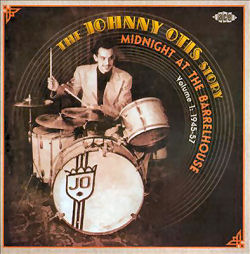 He always seems to have had a drummer in his bands even though he always played drums too. The guy I’ve seen most on YouTube is Leard ‘Kansas City’ Bell (who Johnny had replaced during the recording of Hound Dog). Johnny Otis’ trademark though was a very large (20”?) floor tom which he played at the front of the band and he used to embellish and lead the music even if he was playing keyboards or vibraphone.
He always seems to have had a drummer in his bands even though he always played drums too. The guy I’ve seen most on YouTube is Leard ‘Kansas City’ Bell (who Johnny had replaced during the recording of Hound Dog). Johnny Otis’ trademark though was a very large (20”?) floor tom which he played at the front of the band and he used to embellish and lead the music even if he was playing keyboards or vibraphone.
There is so much to see that shows Johnny Otis at his best on YouTube but I’d say start with ‘Hound Dog’, then ‘Willie And The Hand Jive’, then some of the big band stuff like ‘Harlem Nocturne’. Something to watch for on his television show is the band coming in perfectly in time and with exactly the right feel after a single downbeat wave from Johnny! There’s also a clip of him drumming alongside Lionel Hampton who’s playing vibes and Johnny Otis swings hard!
He was known as ‘The Godfather of Rhythm & Blues’ which from all the evidence is a very well-deserved accolade. His music and drumming is still having a profound effect on modern drummers.
Johnny Otis died on the 17th January 2012.
Bob Henrit
April 2014

